
Am Fam Physician. 2017;96(4):234-239
Author disclosure: Dr. Grad has no relevant financial affiliations. Dr. Ebell is cofounder and editor-in-chief of Essential Evidence Plus, published by Wiley-Blackwell, Inc.
A challenge in the Choosing Wisely campaign is to identify low-value clinical actions supported by high-quality evidence. We applied a method based on crowdsourcing the Daily POEM (patient-oriented evidence that matters) to identify low-value clinical actions from research studies consistent with the principles of Choosing Wisely. In 2016, we analyzed an average of 1,382 questionnaires on 265 unique POEMs delivered to physician members of the Canadian Medical Association. From these questionnaires, we identified the POEMs ranking highest on one questionnaire item directly linked to reducing overdiagnosis or overtreatment. The recommendations from these POEMs based on primary research or meta-analyses are presented as actions to consider avoiding in clinical practice. These recommendations fall into the categories of musculoskeletal conditions (e.g., degenerative meniscal tears, chronic low back pain), cardiovascular disease (e.g., chronic stable angina, heart failure with preserved ejection fraction), respiratory disease (e.g., pneumonia, asthma exacerbations), and preventive care (e.g., screening for lung, colorectal, or ovarian cancer). Based on the results of the studies, these recommendations describe interventions whose benefits are not superior to other options, are sometimes more expensive, or put patients at increased risk of harm. Knowing more about these POEMs and their connection with the Choosing Wisely campaign will help clinicians and their patients engage in conversations better informed by high-quality evidence.
The Choosing Wisely campaign challenges physicians to identify so-called low-value clinical actions supported by high-quality evidence. This article reviews the Daily POEMs (patient-oriented evidence that matters) from recent research that are most consistent with principles of the campaign. However, unlike the actual Choosing Wisely recommendations,1 all recommendations derived from POEMs are based on empirical data from clinical research involving patient-oriented outcomes.2 In addition, because POEMs are selected through a crowdsourcing method, the POEMs in this article were chosen not by experts but by thousands of physicians in a continuing medical education program sponsored by the Canadian Medical Association.3
The selection method is based on big data obtained by linking the daily POEM to a brief validated questionnaire.4,5 In 2016, an average of 1,382 questionnaires on 265 unique POEMs were analyzed to identify the studies ranking highest on one questionnaire item: “This information will help to avoid unnecessary treatment, diagnostic procedures, preventive interventions, or a referral for this patient.” This item was chosen because of its direct link to the Choosing Wisely campaign. To maintain a focus on research studies, POEMs about guidelines were excluded. We also excluded nine of the most relevant POEMs of 2016 that were discussed earlier this year in American Family Physician.6 However, to highlight their importance for clinical practice, these POEMs are available online (eTable A).
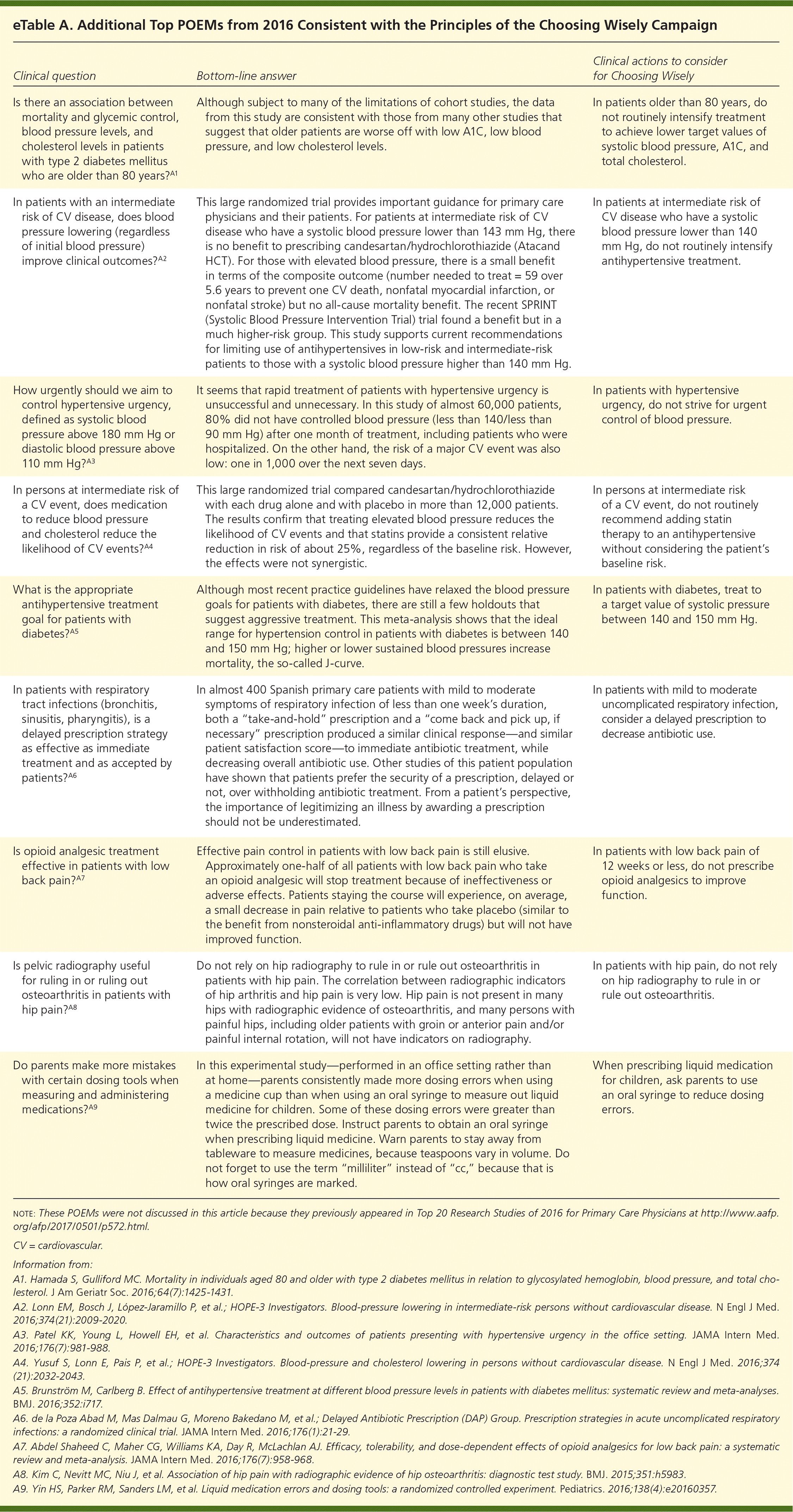
| Clinical question | Bottom-line answer | Clinical actions to consider for Choosing Wisely |
|---|---|---|
| Is there an association between mortality and glycemic control, blood pressure levels, and cholesterol levels in patients with type 2 diabetes mellitus who are older than 80 years?A1 | Although subject to many of the limitations of cohort studies, the data from this study are consistent with those from many other studies that suggest that older patients are worse off with low A1C, low blood pressure, and low cholesterol levels. | In patients older than 80 years, do not routinely intensify treatment to achieve lower target values of systolic blood pressure, A1C, and total cholesterol. |
| In patients with an intermediate risk of CV disease, does blood pressure lowering (regardless of initial blood pressure) improve clinical outcomes?A2 | This large randomized trial provides important guidance for primary care physicians and their patients. For patients at intermediate risk of CV disease who have a systolic blood pressure lower than 143 mm Hg, there is no benefit to prescribing candesartan/hydrochlorothiazide (Atacand HCT). For those with elevated blood pressure, there is a small benefit in terms of the composite outcome (number needed to treat = 59 over 5.6 years to prevent one CV death, nonfatal myocardial infarction, or nonfatal stroke) but no all-cause mortality benefit. The recent SPRINT (Systolic Blood Pressure Intervention Trial) trial found a benefit but in a much higher-risk group. This study supports current recommendations for limiting use of antihypertensives in low-risk and intermediate-risk patients to those with a systolic blood pressure higher than 140 mm Hg. | In patients at intermediate risk of CV disease who have a systolic blood pressure lower than 140 mm Hg, do not routinely intensify antihypertensive treatment. |
| How urgently should we aim to control hypertensive urgency, defined as systolic blood pressure above 180 mm Hg or diastolic blood pressure above 110 mm Hg?A3 | It seems that rapid treatment of patients with hypertensive urgency is unsuccessful and unnecessary. In this study of almost 60,000 patients, 80% did not have controlled blood pressure (less than 140/less than 90 mm Hg) after one month of treatment, including patients who were hospitalized. On the other hand, the risk of a major CV event was also low: one in 1,000 over the next seven days. | In patients with hypertensive urgency, do not strive for urgent control of blood pressure. |
| In persons at intermediate risk of a CV event, does medication to reduce blood pressure and cholesterol reduce the likelihood of CV events?A4 | This large randomized trial compared candesartan/hydrochlorothiazide with each drug alone and with placebo in more than 12,000 patients. The results confirm that treating elevated blood pressure reduces the likelihood of CV events and that statins provide a consistent relative reduction in risk of about 25%, regardless of the baseline risk. However, the effects were not synergistic. | In persons at intermediate risk of a CV event, do not routinely recommend adding statin therapy to an antihypertensive without considering the patient's baseline risk. |
| What is the appropriate antihypertensive treatment goal for patients with diabetes?A5 | Although most recent practice guidelines have relaxed the blood pressure goals for patients with diabetes, there are still a few holdouts that suggest aggressive treatment. This meta-analysis shows that the ideal range for hypertension control in patients with diabetes is between 140 and 150 mm Hg; higher or lower sustained blood pressures increase mortality, the so-called J-curve. | In patients with diabetes, treat to a target value of systolic pressure between 140 and 150 mm Hg. |
| In patients with respiratory tract infections (bronchitis, sinusitis, pharyngitis), is a delayed prescription strategyas effective as immediate treatment and as accepted by patients?A6 | In almost 400 Spanish primary care patients with mild to moderate symptoms of respiratory infection of less than one week's duration, both a “take-and-hold” prescription and a “come back and pick up, if necessary” prescription produced a similar clinical response—and similar patient satisfaction score—to immediate antibiotic treatment, while decreasing overall antibiotic use. Other studies of this patient population have shown that patients prefer the security of a prescription, delayed or not, over withholding antibiotic treatment. From a patient's perspective, the importance of legitimizing an illness by awarding a prescription should not be underestimated. | In patients with mild to moderate uncomplicated respiratory infection, consider a delayed prescription to decrease antibiotic use. |
| Is opioid analgesic treatment effective in patients with low back pain?A7 | Effective pain control in patients with low back pain is still elusive. Approximately one-half of all patients with low back pain who take an opioid analgesic will stop treatment because of ineffectiveness or adverse effects. Patients staying the course will experience, on average, a small decrease in pain relative to patients who take placebo (similar to the benefit from nonsteroidal anti-inflammatory drugs) but will not have improved function. | In patients with low back pain of 12 weeks or less, do not prescribe opioid analgesics to improve function. |
| Is pelvic radiography useful for ruling in or ruling out osteoarthritis in patients with hip pain?A8 | Do not rely on hip radiography to rule in or rule out osteoarthritis in patients with hip pain. The correlation between radiographic indicators of hip arthritis and hip pain is very low. Hip pain is not present in many hips with radiographic evidence of osteoarthritis, and many persons with painful hips, including older patients with groin or anterior pain and/or painful internal rotation, will not have indicators on radiography. | In patients with hip pain, do not rely on hip radiography to rule in or rule out osteoarthritis. |
| Do parents make more mistakes with certain dosing tools when measuring and administering medications?A9 | In this experimental study—performed in an office setting rather than at home—parents consistently made more dosing errors when using a medicine cup than when using an oral syringe to measure out liquid medicine for children. Some of these dosing errors were greater than twice the prescribed dose. Instruct parents to obtain an oral syringe when prescribing liquid medicine. Warn parents to stay away from tableware to measure medicines, because teaspoons vary in volume. Do not forget to use the term “milliliter” instead of “cc,” because that is how oral syringes are marked. | When prescribing liquid medication for children, ask parents to use an oral syringe to reduce dosing errors. |
Musculoskeletal Conditions
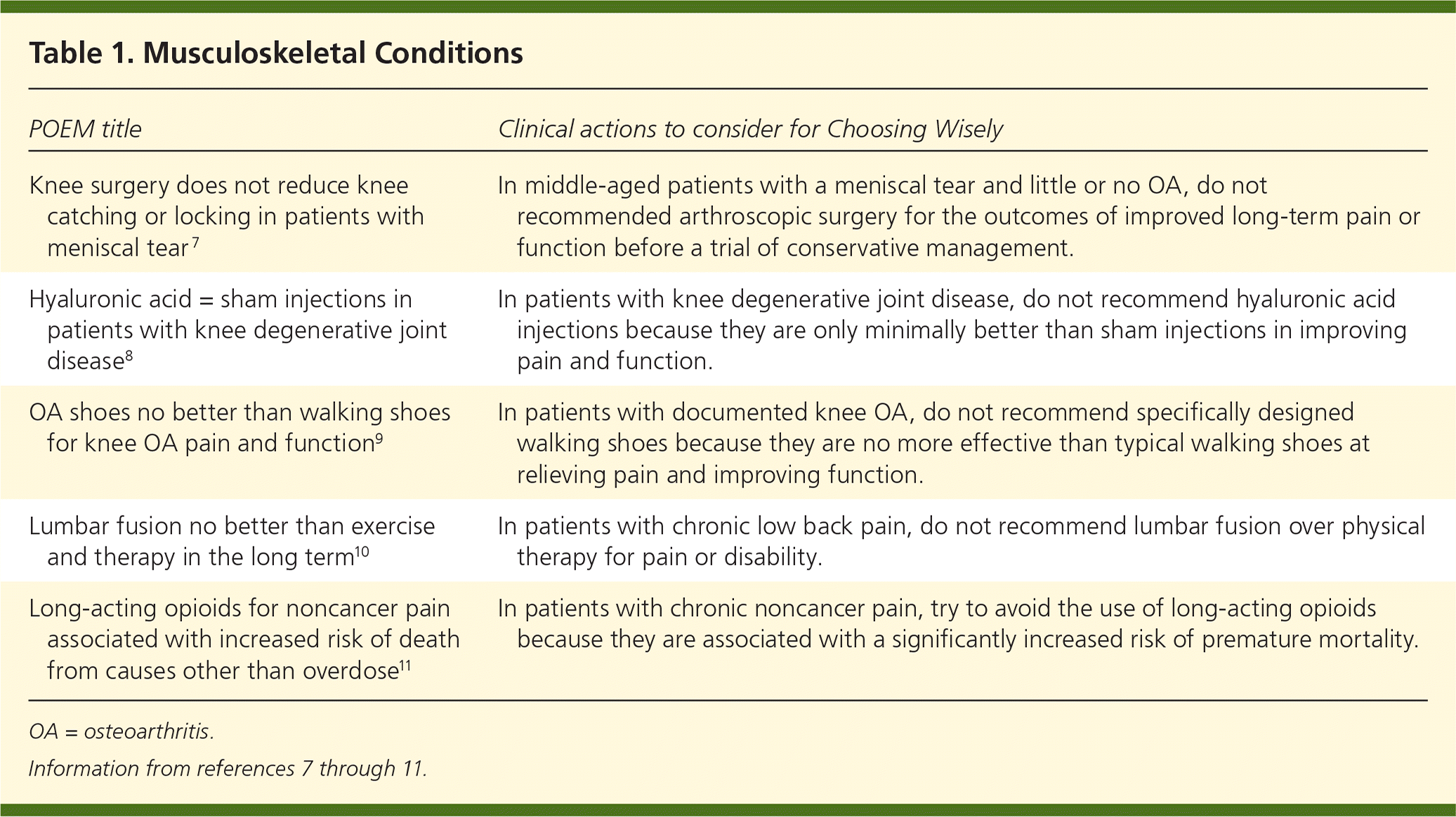
| POEM title | Clinical actions to consider for Choosing Wisely |
|---|---|
| Knee surgery does not reduce knee catching or locking in patients with meniscal tear 7 | In middle-aged patients with a meniscal tear and little or no OA, do not recommended arthroscopic surgery for the outcomes of improved long-term pain or function before a trial of conservative management. |
| Hyaluronic acid = sham injections in patients with knee degenerative joint disease8 | In patients with knee degenerative joint disease, do not recommend hyaluronic acid injections because they are only minimally better than sham injections in improving pain and function. |
| OA shoes no better than walking shoes for knee OA pain and function9 | In patients with documented knee OA, do not recommend specifically designed walking shoes because they are no more effective than typical walking shoes at relieving pain and improving function. |
| Lumbar fusion no better than exercise and therapy in the long term10 | In patients with chronic low back pain, do not recommend lumbar fusion over physical therapy for pain or disability. |
| Long-acting opioids for noncancer pain associated with increased risk of death from causes other than overdose11 | In patients with chronic noncancer pain, try to avoid the use of long-acting opioids because they are associated with a significantly increased risk of premature mortality. |
In last year's summary of POEMs consistent with Choosing Wisely, two POEMs about degenerative meniscal tears were highlighted.12 Based on meta-analyses of trials, arthroscopic meniscectomy was not an effective treatment. However, in patients with the specific symptoms of knee locking or catching, is arthroscopic meniscectomy beneficial? Using data collected in a larger trial, researchers followed 146 patients 35 to 65 years of age with knee pain and degenerative meniscal tears to see if meniscectomy was more effective than sham surgery in relieving symptoms of knee locking or catching. Results found that meniscectomy was not more effective.7 A patient summary is available to help inform patients with meniscal tears who request a referral for orthopedic surgery: http://annals.org/aim/article/2490534/mechanical-symptoms-arthroscopic-partial-meniscectomy-patients-degenerative-meniscus-tear.13
Regarding treatments for improving pain and function in patients with knee degenerative joint disease, a meta-analysis of 19 trials with nearly 4,500 patients concluded that hyaluronic acid injections are only minimally better than sham injections.8 In addition, persons who receive platelet-rich plasma injections are not better off in terms of symptoms and function score.14 For a therapeutic option that provides an effect better than placebo, consider treatment with diclofenac.15
Some shoes are specifically designed for arthritis of the knees by using modified midsoles and a lateral wedge to decrease the load on the medial aspect of the knee. An Australian trial enrolled 164 patients 50 years or older who had knee pain rated at least 4 on a scale of 0 to 10 on most days and radiographic evidence of medial knee osteoarthritis. These special shoes were no more effective than typical walking shoes at relieving pain and improving function.9 Knowing this could save patients money.
Is lumbar fusion effective for improving pain and disability in patients with chronic low back pain, and what are its potential harms? Compared with decompressive surgery alone, the harms of adding lumbar fusion can include a longer length of hospital stay, higher cost, longer operative time, and greater blood loss. A Swedish randomized trial of 294 persons with severe chronic low back pain compared lumbar fusion with physical therapy and did not find any clear benefit after a mean follow-up of 12.8 years.10 The findings of this trial are consistent with others that added lumbar fusion to decompression in patients with lumbar spinal stenosis.16
In patients with acute low back pain who visit the emergency department, opioids appear to be no more effective than nonsteroidal anti-inflammatory drugs and have a higher rate of adverse effects.17 Another study examined whether long-acting opioids such as morphine, oxycodone, methadone, and transdermal fentanyl increase the risk of death from causes other than overdose in adults with chronic noncancer pain. This analysis of Tennessee Medicaid records found 68.5 excess deaths per 10,000 person-years of follow-up in the cohort receiving opioids; of these deaths, more than one-half were caused by a cardiovascular event.11 This association suggests that patients with chronic noncancer pain fare worse with, but not necessarily because of, long-acting opioid use.
Cardiovascular Disease
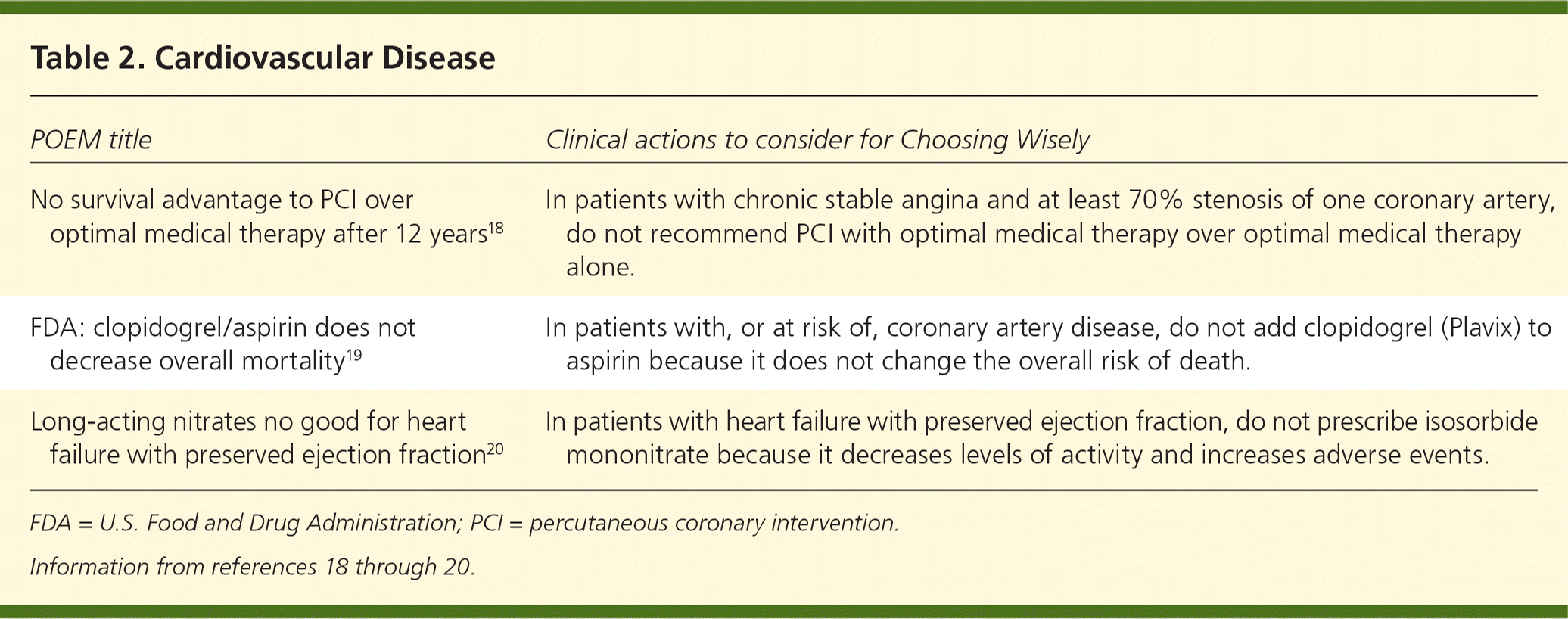
| POEM title | Clinical actions to consider for Choosing Wisely |
|---|---|
| No survival advantage to PCI over optimal medical therapy after 12 years18 | In patients with chronic stable angina and at least 70% stenosis of one coronary artery, do not recommend PCI with optimal medical therapy over optimal medical therapy alone. |
| FDA: clopidogrel/aspirin does not decrease overall mortality19 | In patients with, or at risk of, coronary artery disease, do not add clopidogrel (Plavix) to aspirin because it does not change the overall risk of death. |
| Long-acting nitrates no good for heart failure with preserved ejection fraction20 | In patients with heart failure with preserved ejection fraction, do not prescribe isosorbide mononitrate because it decreases levels of activity and increases adverse events. |
In patients with chronic stable angina and at least 70% stenosis of one coronary artery, is percutaneous coronary intervention with optimal medical therapy better than optimal medical therapy alone? The original COURAGE (Clinical Outcomes Utilizing Revascularization and Aggressive Drug Evaluation) trial was extended to follow more than one-half of the patients over a median of 11.9 years. In this follow-up study, researchers found no difference in all-cause mortality between groups.18 This study did not address whether patients in the percutaneous coronary intervention group were more functional or had less angina.
The next study addresses the question, is long-term treatment with clopidogrel (Plavix) plus aspirin effective in decreasing overall mortality in patients who have had an acute coronary syndrome or who are at risk of coronary artery disease events?19 The U.S. Food and Drug Administration conducted a meta-analysis of 12 randomized controlled trials. Overall, there was no decrease—or increase—in mortality from any cause in patients treated with long-term clopidogrel plus aspirin compared with short-term use or aspirin alone (long-term use of 12 months or longer = 6.7% mortality vs. short-term use of six months or less, or aspirin alone = 6.6% mortality). This absence of benefit warrants consideration when recommending specific antiplatelet treatment to patients with a history of acute coronary syndrome.
Finally, certain drugs that help patients with congestive heart failure and a decreased ejection fraction should not routinely be used in patients with heart failure and a preserved ejection fraction. For example, long-acting nitrates are not beneficial for patients with heart failure and a preserved ejection fraction.20 This finding can provide opportunities to discontinue these prescriptions in some patients with congestive heart failure.
Respiratory Disease
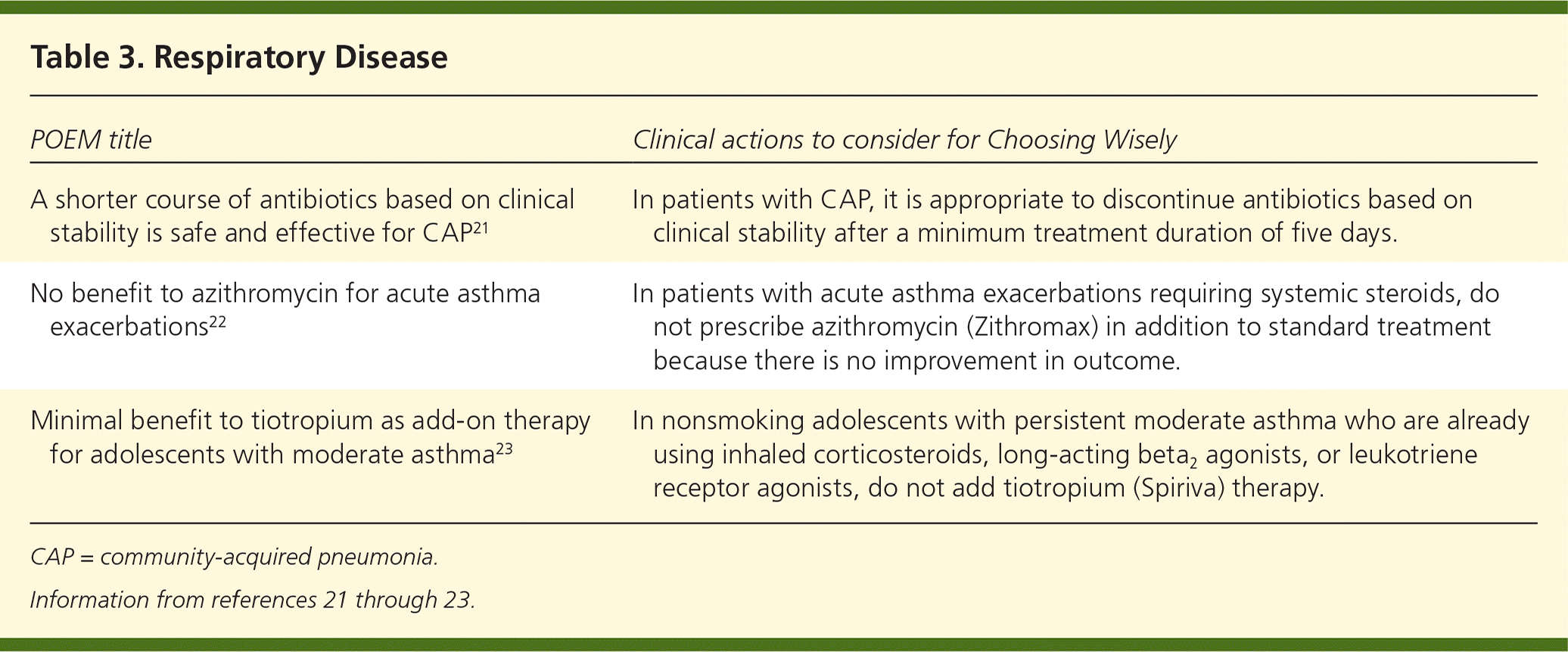
| POEM title | Clinical actions to consider for Choosing Wisely |
|---|---|
| A shorter course of antibiotics based on clinical stability is safe and effective for CAP21 | In patients with CAP, it is appropriate to discontinue antibiotics based on clinical stability after a minimum treatment duration of five days. |
| No benefit to azithromycin for acute asthma exacerbations22 | In patients with acute asthma exacerbations requiring systemic steroids, do not prescribe azithromycin (Zithromax) in addition to standard treatment because there is no improvement in outcome. |
| Minimal benefit to tiotropium as add-on therapy for adolescents with moderate asthma23 | In nonsmoking adolescents with persistent moderate asthma who are already using inhaled corticosteroids, long-acting beta2 agonists, or leukotriene receptor agonists, do not add tiotropium (Spiriva) therapy. |
Patients hospitalized for community-acquired pneumonia often receive 10 days of antibiotic treatment; however, fewer days of treatment may be just as effective. Among patients without complications who were not immunosuppressed or admitted to the intensive care unit, a minimum of five days of antibiotic therapy was as safe and effective for treating community-acquired pneumonia as a 10-day course.21 Criteria for discontinuing antibiotics included the absence of hemodynamic instability and being afebrile for at least 48 hours. Although this trial recruited inpatients, study results can likely be extrapolated to patients with less severe community-acquired pneumonia treated exclusively in the community.
The next study asks whether there is a role for azithromycin (Zithromax) in treating an acute asthma exacerbation that requires systemic steroids. In the United Kingdom, 199 patients who had not received an antibiotic in the previous month were randomized to receive azithromycin, 500 mg daily, or matching placebo for three days in addition to standard care.22 No differences were detected between groups for the outcomes of asthma symptoms, quality of life, or lung function. When managing an acute asthma exacerbation, the findings of this trial align with guidelines that recommend against prescribing antibiotics.24
Tiotropium (Spiriva), a medication for chronic obstructive pulmonary disease, has a potential role in reducing exacerbations in patients with severe asthma.25 Does this observation justify its use as add-on therapy for patients with nonsevere symptoms? A randomized controlled trial found only minimal benefit to tiotropium as add-on therapy for adolescents with moderate asthma,23 a finding that will help reduce prescription drug expenses for families of teenagers with asthma.
Preventive Health Care
Patients often overestimate the potential for benefit from screening or preventive interventions while underestimating the potential for harm.26 It can be challenging to explain this in the typical primary care visit. Becoming familiar with these POEMs on preventive care (Table 427–31 ) may help improve conversations with patients beyond a binary recommendation for or against certain cancer screenings, lipid-lowering therapy, and prevention of urinary tract infection in nursing home residents.
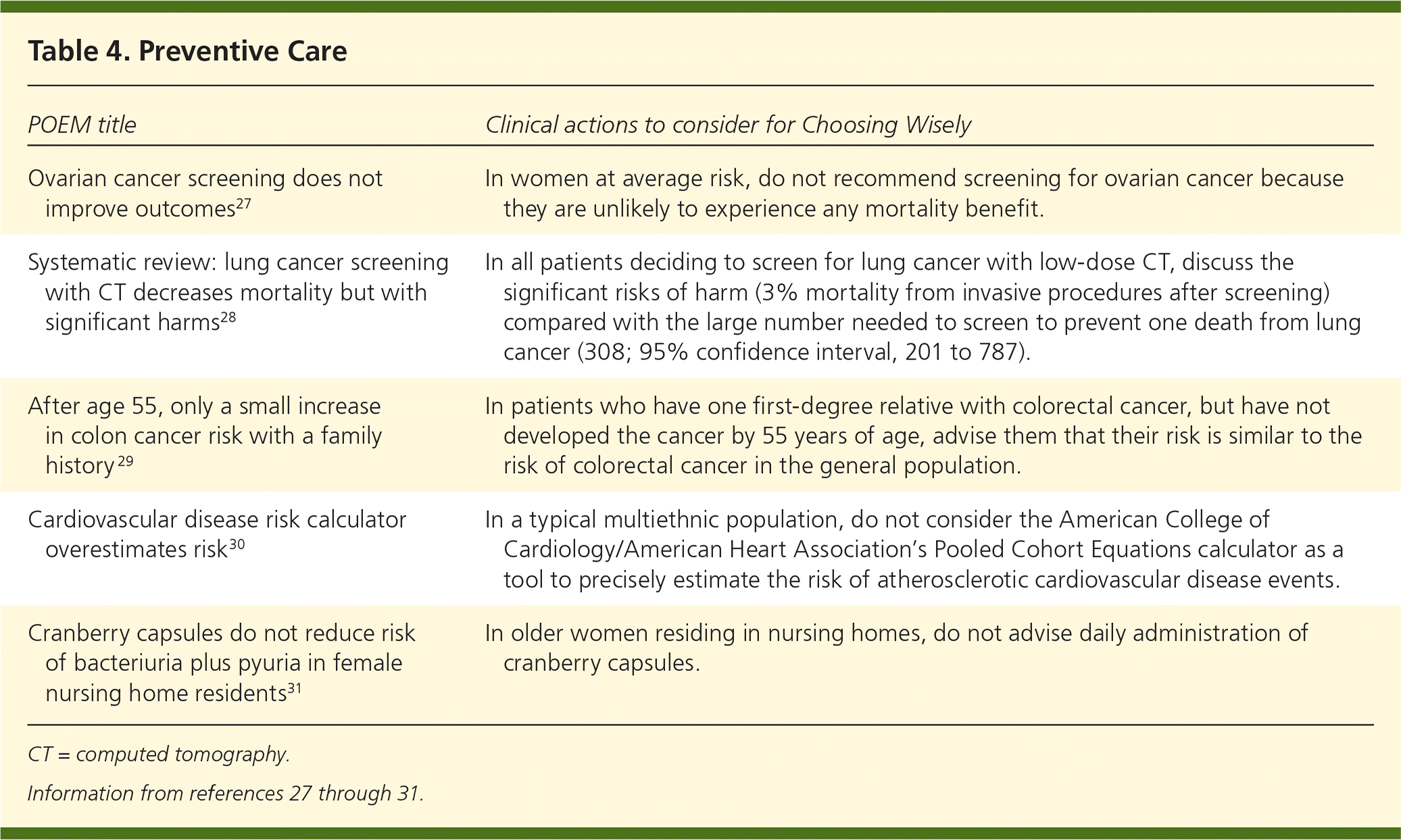
| POEM title | Clinical actions to consider for Choosing Wisely |
|---|---|
| Ovarian cancer screening does not improve outcomes27 | In women at average risk, do not recommend screening for ovarian cancer because they are unlikely to experience any mortality benefit. |
| Systematic review: lung cancer screening with CT decreases mortality but with significant harms28 | In all patients deciding to screen for lung cancer with low-dose CT, discuss the significant risks of harm (3% mortality from invasive procedures after screening) compared with the large number needed to screen to prevent one death from lung cancer (308; 95% confidence interval, 201 to 787). |
| After age 55, only a small increase in colon cancer risk with a family history 29 | In patients who have one first-degree relative with colorectal cancer, but have not developed the cancer by 55 years of age, advise them that their risk is similar to the risk of colorectal cancer in the general population. |
| Cardiovascular disease risk calculator overestimates risk30 | In a typical multiethnic population, do not consider the American College of Cardiology/American Heart Association's Pooled Cohort Equations calculator as a tool to precisely estimate the risk of atherosclerotic cardiovascular disease events. |
| Cranberry capsules do not reduce risk of bacteriuria plus pyuria in female nursing home residents31 | In older women residing in nursing homes, do not advise daily administration of cranberry capsules. |
For patients who inquire about screening for ovarian cancer, the findings of the U.K. Collaborative Trial of Ovarian Cancer Screening are most relevant. In this large trial, 200,000 women 50 to 74 years of age were randomized to cancer antigen 125 testing guided by a novel algorithm, ultrasonography, or no screening, and followed for a median of 11 years.27 No reduction in ovarian cancer mortality was found. A post-hoc analysis suggests a possible small benefit, but researchers will need at least three more years of follow-up to see if these results stand. In the meantime, good science backs the U.S. Preventive Services Task Force, which recommends against screening for ovarian cancer in average-risk women.32
To inform a recommendation on lung cancer screening, a systematic review was commissioned by the Canadian Task Force on Preventive Health Care. This review found that screening with computed tomography decreases lung cancer mortality and all-cause mortality, although there are important harms from downstream consequences of false-positive tests.28 Lung cancer screening may be most cost-effective in patients who are current smokers in their 60s.33 There appears to be a close trade-off between the potential for benefit and harm. In this context, patients may appreciate a shared decision-making approach that starts with an understanding of the harms and benefits of screening computed tomography. Of note, screening current or former smokers using chest radiography has no effect on lung cancer mortality.
When a relative is diagnosed with colorectal cancer, other family members often present with a request for screening colonoscopy. The findings of a large study of persons 55 to 74 years of age suggest that the assumptions on cancer risk can be reconsidered.29 In persons who have not developed colorectal cancer by 55 years of age, having a single first-degree relative with colorectal cancer was associated with only a small increase in colorectal cancer risk (hazard ratio = 1.23; 95% confidence interval, 1.07 to 1.42), with no differences in cancer risk based on age at diagnosis in that relative.
Two POEMs to help avoid overtreatment are also worthy of mention. The first suggests that the Pooled Cohort Equations risk calculator to predict atherosclerotic cardiovascular disease substantially overestimates the percentage of patients who will benefit from lipid-lowering treatment.30 An alternative to this is the Framingham calculator, which calculates the risk of heart attack plus angina plus heart failure plus stroke plus intermittent claudication.34 The second POEM addresses polypharmacy in older patients. A trial of cranberry capsules did not reduce the risk of bacteriuria plus pyuria, or urinary tract infection, in female nursing home residents.31
editor's note: This article was cowritten by Dr. Mark Ebell, Deputy Editor for AFP and cofounder and Editor-in-Chief of Essential Evidence Plus, published by Wiley-Blackwell, Inc. Because of Dr. Ebell's dual roles and ties to Essential Evidence Plus, the article underwent peer review and editing by three of AFP's medical editors. Dr. Ebell was not involved in the editorial decision-making process.—Jay Siwek, MD, Editor, American Family Physician
See the top POEMs of 2015 consistent with the Choosing Wisely campaign at https://www.aafp.org/afp/2016/1001/p566.html.12
